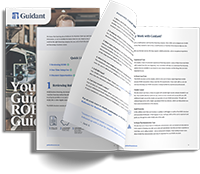Companies and their employees are freer than ever to work wherever they like.
The success of remote work and the COVID-19 pandemic continue to pave the way for an increasing number of professionals to work from home. Some companies have adopted fully hybrid workplace models—others have even shuttered their traditional office locations to work fully remote. Before the pandemic, only 16% of companies in the world were fully remote. In 2020, almost 70% of full-time employees worked from home.
Our small business relocation series explores what businesses should know about moving to (and from!) different cities and states. We’ll also look at how relocation impacts aspects of life beyond a new physical business address. Future posts will examine how moving impacts employees and the benefits that come with remote and in-office work.
Here are the 6 factors you should consider when relocating an existing business from one physical address to another:
- Know your reasons for relocating
- Choose a new location for your business
- Double-check the cost of moving
- Necessary tasks before the move
- Agencies to contact about your move
- How to move your business out of state
1. Know Your Reasons for Relocating
Before moving to a new business location, it’s essential to understand why you’re moving in the first place.
It’s a common mistake to rush the decision to move. There’s no guarantee that relocation will be the “right” move for your business. As such, it’s critical to conduct your due diligence before making a permanent move. Why is your business moving? How will the move be beneficial for your company now and into the future? Take your time as you determine if and where you would like to permanently relocate your business.
For example, MyCorporation moved because our previous commercial space was physically too small to accommodate our growing team of employees. We needed a bigger, more open office for everyone. The previous office space was very literally limiting our business growth in more ways than one.
Aside from business expansion, here are a few other things to consider before relocating your business:
- New markets. Is your target market no longer in the same area as your business? You may relocate to an area or community where there is higher traffic frequented by your target market.
- Hiring opportunities. Relocation offers the chance for businesses to tap into a qualified, educated, and talented workforce— but the opposite can be true, too, especially if you are a niche business. Are there enough workers in your new market that specialize in what you do?
- Opportunity to lower costs. Some business owners may discover they can significantly save on rent and utility rates if they move out of expensive cities and into suburban areas.
- Tax incentives. Tax rates can seriously influence the size of your profit margin, and those tax rates are primarily determined by location. Look for a location with tax rates amenable to you. Some locations even offer tax credits for businesses in specific industries!
- Employee experience. Employees want to work for companies that keep their needs in mind. Is your new location better or worse for your employees? Existing employees may like or dislike the new location for reasons of commute time or proximity. These and other factors will influence whether your present employees are ready to relocate with you.
- Customer experience. How will your customers be impacted if you move? If your business relies on one type of client or market, be cautious about how relocating could impact that business relationship.
- Better quality of life. If the area you currently work in has gradually grown unsafe or unhealthy, moving presents the chance for a better quality of life. Relocation may also help attract emerging talent to your business.

2. Choose a New Location for Your Business
Once you’re sure relocating your business is right for you, the next step is finding a location.
Remember your new physical office should be able to accommodate the needs of the business, its clientele, and its employees. Is the building easy to access by cars and public transportation? How many parking spots are there? Is the building accessible for disabled employees and clients, or burdensome to navigate? Do you need a post office nearby? If it’s relevant, how close are you to an airport?
The commercial real estate space becomes more flexible in times of uncertainty (such as the COVID-19 pandemic). Depending on the needs of your business and how your team works, you may be able to negotiate a shorter lease term than a traditional multi-year lease. Discuss this with a landlord to ensure you’re getting the lease that works best for your business.
3. Double-Check the Cost of Moving
Once you know where your business is moving to, you’ll need to make sure the cost of the move won’t outweigh the benefits. After all, relocating your entire business can be expensive. First, outline a budget for your move. For instance, you may need to hire a moving company to help move larger pieces of furniture, like desks and chairs. Establish a timeline that allows you to set critical dates for the move in stone. This will make the next few steps easier.
Make sure the cost of the move won’t outweight the benefits. After all, relocating your entire business can be expensive.
Deborah Sweeney, MyCorporation CEO
5. Agencies To Contact Before Your Move
If your business moves within the same city and state where it was incorporated, chances are you’re familiar with the local jurisdiction. Here are some of the authorities you’ll need to contact at the federal, state, and local city and county levels regarding your relocation.
- Federal: Complete Form 8822 Change of Address with the IRS. This form notifies the IRS about the change in your business address.
- State: Reach out to your local Secretary of State for the next steps regarding your address change. The documents you need to amend will depend on the entity you are incorporated as. For example, a corporation would amend its articles of incorporation. In contrast, an LLC would amend articles of organization with the new address information. You will also need to contact the state department of revenue regarding the change in address for sales and state income tax purposes.
- City and/or County: Your business might have obtained specific business licenses and permits for its operations. Contact the locality to notify officials about the change of address and provide your new address information. Certain offices, such as zoning offices, may need to approve your change of address before the move.
- Cancel local business licenses and permits. Apply for new business licenses and permits in your new state.
- Close your existing business bank account and reopen another account. (Side note: this is only applicable if your regional bank does not have nationwide branches.)
- Apply for a new doing business as (DBA) name in the new state and withdraw your existing DBA from the old state.
6. How To Relocate Your Business to a New State
What happens if you’re relocating your business outside your initial state of incorporation?
Preparing to relocate your business to another state requires more than a simple moving checklist. You need to formally plan for how you’re going to relocate your business entity. Incorporated businesses have three options for changing their state of formation:
- Dissolving the existing LLC or corporation in its original state of incorporation and incorporating or forming a new LLC in the new state.
- Merging the old LLC or corporation with an LLC or corporation formed in a new state.
- Filing a foreign qualification.
For posterity, we’ll use the examples of companies incorporated as either a limited liability company (LLC) or a corporation that are relocating to a new state. Then, we’ll share best practices for changing your existing formation state to the new state where you will conduct business.
1. Dissolution and Formation
Let’s say you own a bakery in Oregon. This bakery has an Oregon LLC. You decide to close the Oregon bakery and relocate to California. When you do, you may decide to form a California LLC.
Making this change requires going through steps of dissolution and formation.
Dissolving a business means formally closing the business and its state of incorporation. It is necessary to end the legal existence of your business in a state where it no longer plans to do business. If you don’t, the state of incorporation will consider the business to still be active, and you’ll still be required to pay state fees and taxes and file annual reports.
Dissolving a business, while a voluntary action, requires all members to agree on the decision. To determine the protocol for properly dissolving the business, you may return to key documents, such as an LLC’s operating agreement (corporate bylaws for a corporation). Generally, a meeting is held where members vote to dissolve and minutes are taken on the resolution’s outcome.
Once you have received a majority vote to dissolve the entity, follow the necessary steps for dissolving the business. This includes filing articles of dissolution with the current Secretary of State, sending notices and cancellations in a dissolution proposal, paying back creditors, settling debts, terminating your 401(k) plan if you have one, and distributing assets accordingly to owners and members.
After a successful dissolution, the owners or members may form a new corporation or LLC in the new state. Remember to follow the rules presented by the new Secretary of State to ensure your new LLC or corporation stays in compliance in its new state of formation.
2. Merger
Not sure that filing a dissolution is the best decision for your corporation or LLC? You may choose to change your state of formation via merger.
A merger is essentially a reorganization. You would form a corporation or LLC in the new state where you plan to do business. You then merge the old LLC into the new corporation. The old LLC ceases to exist. Its owners become the owners of the new LLC, and its assets are granted to the new LLC.
Most states have laws that permit entity formations, like LLCs, to merge into another LLC. Suppose you’re interested in using a merger. In that case, you will need to follow the guidelines placed by the new state of incorporation’s LLC and corporation laws. For example, you may be required to file articles of merger when forming the new LLC.
3. Foreign Qualification
What if neither option presented above sounds like a fit for your business? What if you are relocating to a new state but plan to keep doing business in your old state?
There’s another alternative available to incorporated businesses. Rather than change your state of formation, you can file a foreign qualification in the new state.
Filing a foreign qualification allows you to keep your old entity, like an LLC, and register it as a foreign LLC in the new state.
A foreign entity will need to obtain a certificate of authority from its existing Secretary of State. This document shows that the business is authorized to do business in a state different from its state of formation. In addition, you will need to obtain a certificate of good standing from the Secretary of State. This acts as proof that your business is in good standing with its state of incorporation. Remember to pay the associated filing fees during the registration process.
7. Necessary Tasks Before You Relocate Your Small Business
Once you have a physical space and have notified the appropriate agencies about your change of address, you’ll need to create a moving checklist. Check these items off as you prepare to relocate.
- Update employees. At this point, you’ve likely shared with employees that the business is moving to a new location. Make sure your team knows where you’re moving and the timeline for the move.
- Update customers. Keep your customer base in the loop about your move. You may share the news about the new location through social media, newsletters, or the company website. If you need to close for a day or two to complete the move, notify your customer base about when you may be closed for moving purposes and how they’ll be able to contact you.
- Update online assets and platforms. Be prepared to updateyour website, social media, and email signatures with your new address. Don’t forget the easy-to-forget online assets, like Google Maps and Google My Business!
- Order new marketing and advertising materials. You may decide to order new signage for the business — such as a sign for the building — before relocating the business. Update all marketing materials with your new address, like business cards and brochures, by ordering new print materials.
- Set up the business phone and internet in the new space. Once you turn off these services in your existing location, you want the services set up in the new location as soon as possible. This ensures a seamless move and customer experience.
- Schedule the move. The best time to do this is outside traditional office hours.
And that’s it! Enjoy your new location, and celebrate the completion of what was likely a titanic effort! Join us next month for the next installment in our small business relocation series. We’ll discuss employee relocation and the role small businesses play in assisting employees.
Deborah Sweeney is the CEO of MyCorporation.com. MyCorporation is a leader in online legal filing services for entrepreneurs and businesses, providing start-up bundles that include corporation and LLC formation, registered agent, DBA, and trademark & copyright filing services. MyCorporation does all the work, making the business formation and maintenance quick and painless, so business owners can focus on what they do best. Follow her on Twitter @deborahsweeney and @mycorporation.



















